The streets of Castlewellan were lined as the town came alive with music, song, pageantry and theatre as more than 2,000 Republicans from across South Down and further afield gathered on Easter Sunday to commemorate the Centenary of the 1916 Easter Rising.
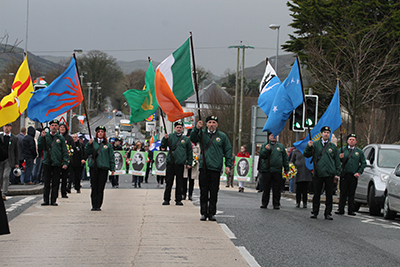
Led out by a Republican Colour Party followed by locals carrying portraits of the leaders of the Rising executed in 1916, the annual parade left a packed Bann Road and made its way up through the Main Street in Castlewellan.
The ever present St Joseph’s Longstone Pipe Band were followed by a number of people in Uniforms of the day with replica weapons from the period of the Rising and war of Independence. Pictures of the South Down IRA Volunteers were carried by relatives along with portraits of the Hunger Strike now in its 35th anniversary.
Participants also carried banners marking the local companies who fought in the War of Independence.
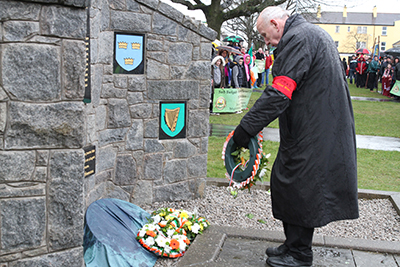
Hundreds of people, many in period dress filed behind the Croi An Dúin Band followed by the James Connolly Republican Flute Band who came over from Glasgow for the occasion. Local GAA clubs and Cultural groups took part in the the parade proudly displaying their banners and colours.
As the lead colour party made its way past the large Tricolour erected on the Market House in Castlewellan Square, the parade now filled the full length of the Main Street as onlookers looked on from every vantage point.
Check out the photos on Facebook
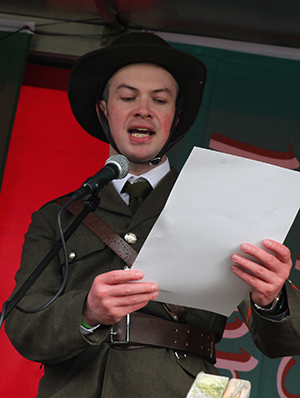
Newcastle Road was themed as ‘History Road’. Street theatre scenes were acted out giving a snapshot of Irish History from different eras. These included Thomas Russell in 1798 through the Irish Famine period, the Easter Rising, Internment, Blankets Protests and Hungers Strikes.
The Parade finished at the Republican monument on the Lower Square where wreaths were laid on behalf of the Republican movement, organising committees, POW’s, Sinn Féin Cumainn, and Newry, Mourne & Down District Council and families whose relatives were involved in 1916. .
Caitriona Ruane MLA and Michael Gray-Sloan chaired proceedings as Orla Rice read the South Down Volunteers Roll of Honour and Patrica Torney read the Hunger Strike Roll of Honour marking the 35th Anniversary.
Sheila Caulfield , who had arrived in from New Jersey to pay tribute to her father, James Caulfield from Warrenpoint, who was a 4th Northern Division IRA Volunteer who participated in the events of the Easter Rising. Also present was Newry, Mourne & Down Council Chairperson Micky Ruane who unveiled a plaque with Shiela in honour of the men and women of 1916.
Sean Cunningham, in the regalia of an Irish Volunteer, then marched forward in full uniform, took the to the Stage and read the Proclamation of the Irish Republic.
Hazzard Delivers Centenary Commemoration Speech
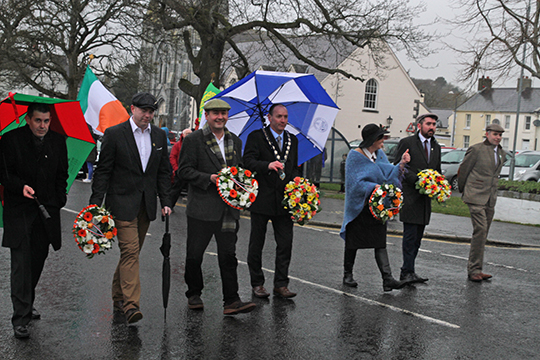
Events rounded off as Chris Hazzard MLA, the main speaker, looked at the past present and future of republicanism in Ireland and exhorted those present to play their part in a a Sinn Féin victory in the May Stormont election.
Chris Hazzard welcomed everyone including the families of the patriot dead and said: “We come together to remember our patriot dead, not to mourn them, but to honour and pay tribute to their sacrifice, heroism and inspiration. Paidgrig Pearse said at his court martial in 1916: ‘If you strike is down nw, we shall rise again and rebnews the fight. You cannot conquer Ireland. You cannot extinguish the It=rish passion for freedom. If our deed has not bee sufficient to win freedom, them our children will win it by a better dead.’
“Pearse has proven that our desire for freedom would not be extinquished. Following the Rising, hundreds joined the ranks of the IRA and the Cumann nahBann here in County Down.”
Chris Hazzard said that the men and women of the Rising rejected the oppression of servitude living in the worst slums in Europe and rose as equals. “This was not just a watershed in Irish histopry in 1916 but a call to arms across the nations of the world who also longed for freedom. The Irish revolution triggered the first world-wide, anti-colonial struggle.
“Seizing territories through conquest and war, Britain maintained its imperial realm with an iron fist… indigenous languages were uprooted, native people enslaved, natural resources plundered, and a ruling class parachuted in to maintain law and order. And so it was in Ireland.
“The Easter Rising in 1916 marked a breach in the ramparts of the British colonial system in Ireland. The Irish nation was reborn. Everything was changed. And when the Irish people refused to recognise the historic mandate for independence in 1018, the Irish people in their thousands joined the rejuvenated ranks of the IRA.
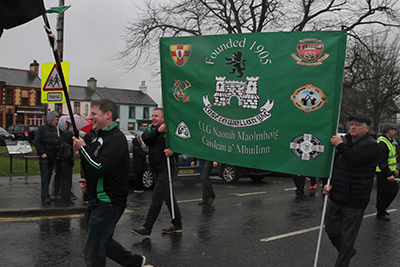
“So today let us have pride in our language. anthem, and our flag, and pride in the pursuit of freedom.
“The Proclamation was a revolutionary document in 1916 and remains so today as a mission statement for modern day Irish republicans. That is the radical heritage we must embrace if we are to meet the challenges of building a new republic.
“PAryition and counter-revolution has achieved nothing but a cyclye of economic failure, emigration, inequality, and two political states weighted against the rights of citizens, the interests of Irish men and women and children. Our island has been torn asunder, our people divided, our fortunes scattered to the winds as we have said goodbye to family and friends.
“Sinn Féin today has carved out a peaceful and democratic route to Irish unity, a vision based on the principles of the 1916 Proclamation.
“Following a hugely success election in the South last month, we ned now to build on this on the 5th May election in the North… the same day as the anniversary of Bobby Sand’s death. We want to send the biggest Sinn Féin team yet to Stormont.
“If you can help us over the next month with the election, even in a small way, you will be made very welcome. It will be a fitting tribute to our patriot dead.”
DUP Condemns Large Tricolour On Castlewellan Library During 1916 March
Newry Mourne and Down District Councillor Garth Craig, speaking on behalf of the DUP expressed his annoyance as the hanging of a massive Tricolor on the scaffolding of the Castlewellan Library during the republican march in Castlewellan to commemorate the 1916 Easter Rising.
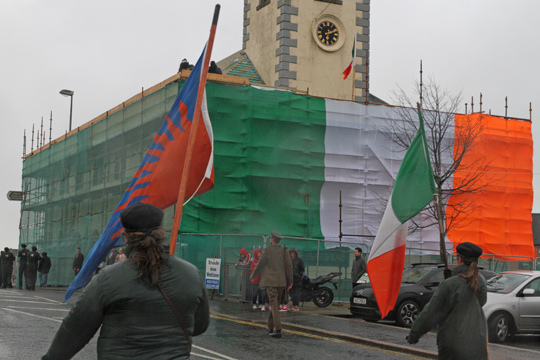
Councillor Craig said: “We are incensed at the blatant act of provocation designed to stor up tension within the Protesteant and Unionist community, and we condemn the deliberate attempt to alienate the Unionist community.
“The Castlewellan library is a shared space. The hanging of this very large flag raises the question, what part of the equality agenda does this fit into?
“Speaking on behalf of my DUP colleagues, we will strongly resist acts that will bring us back to the bad old days and we call on those Nationalists and Republicans responsible to condemn this action.”
The Triclour flag was put up on the morning of the march and it was taken down immediately after the commemoration ceremony ended.
























